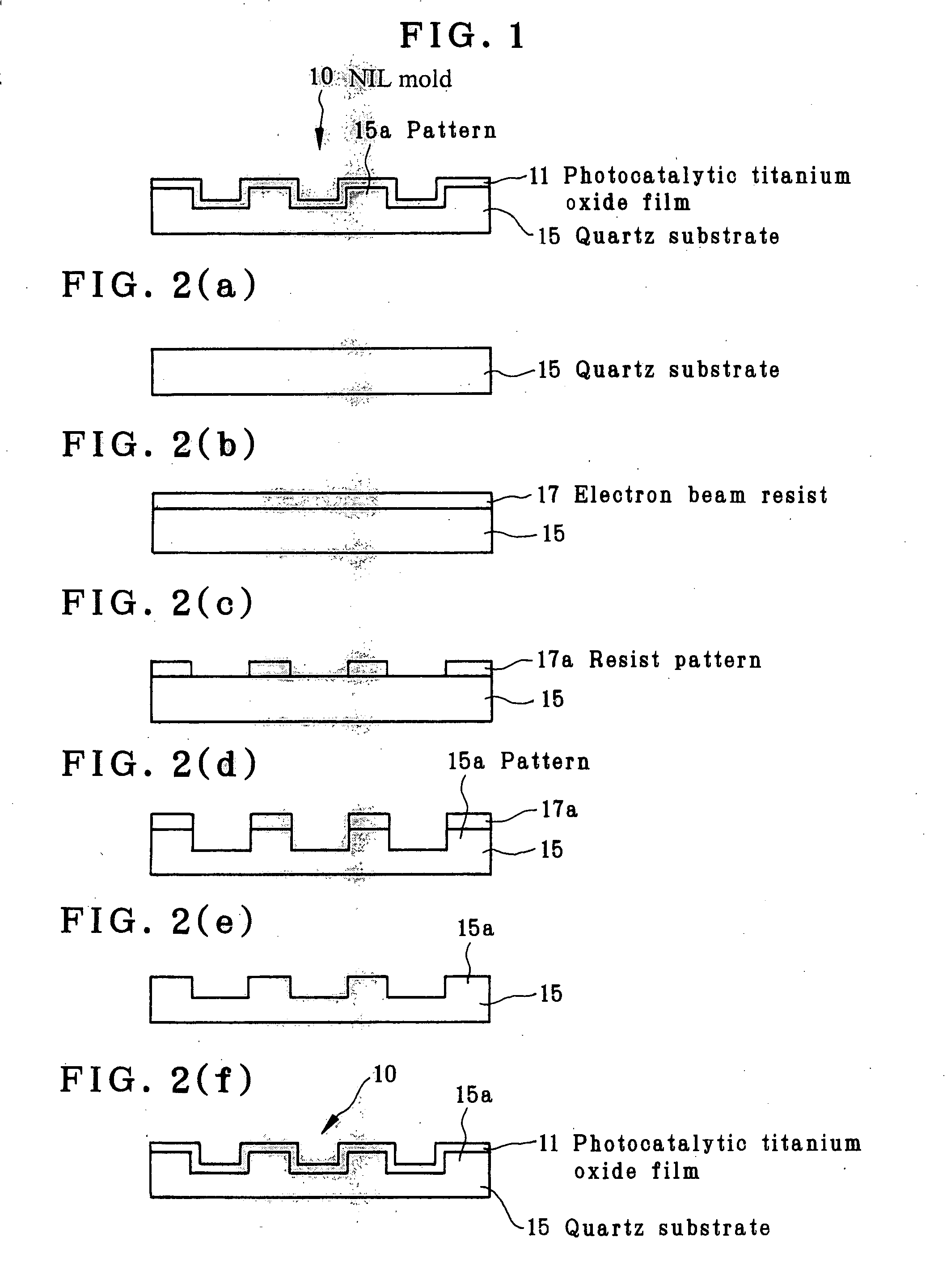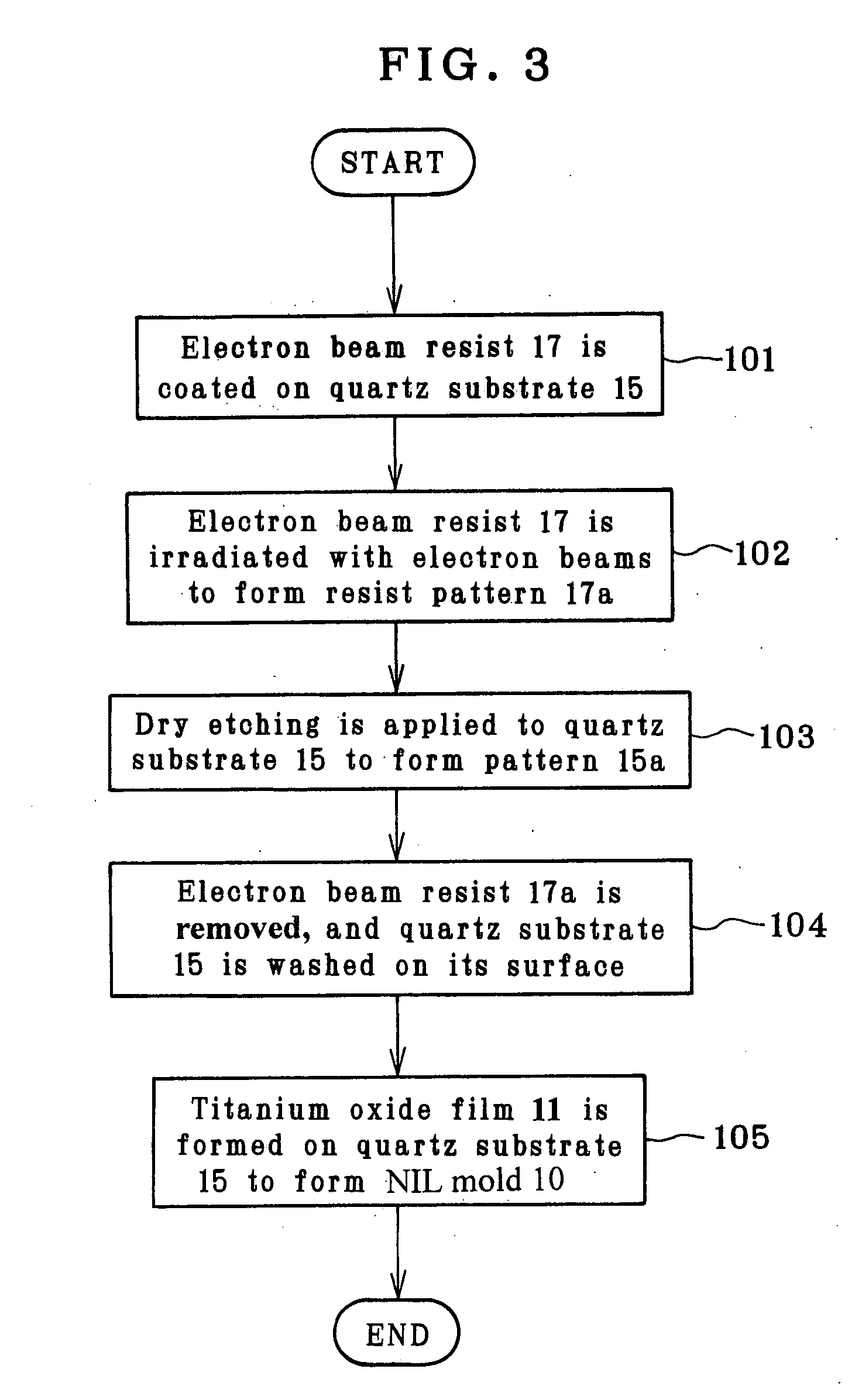Mold for photocuring nano-imprint and its fabrication process
a technology of nano-imprints and molds, which is applied in the field of molds for photocuring nano-imprints and their fabrication processes, can solve the problems of high cost of systems used with such photolithography, difficult to form the desired pattern, and expensive fabrication technologies, and achieves the effect of improving robustness and high releasability
- Summary
- Abstract
- Description
- Claims
- Application Information
AI Technical Summary
Benefits of technology
Problems solved by technology
Method used
Image
Examples
example 1
[0078] A novolac resin type electron beam resist (ZEP-520 made by ZEON Co., Ltd.) is coated at a thickness of 100 nm on the surface of a cuboidal quartz substrate having an outside shape of 6 inches in length, 6 inches in width and 0.25 inch in height, then subjected to electron beam lithography, and finally developed to form a line form of resist pattern having a line width of 70 nm.
[0079] Then, carbon tetrafluoride (CF4) is used as etching gas to dry etch the quartz substrate, after which an unnecessary portion of the electron beam resist is ashed off by oxygen gas to obtain a pattern of three-dimensional configuration having a width of 70 nm and a depth of 100 nm.
[0080] Then, sputtering is carried out using a titanium target as the target and argon and oxygen as the sputtering gas at an input power density of 7 W / cm2, after which sintering is done at 400° C. to obtain a photocatalytic titanium oxide film of 5 nm, in thickness, thereby obtaining a mold according to the invention...
example 2
[0083] Cr was sputtered at a thickness of 10 nm on the surface of a cuboidal quartz substrate having an outside shape of 6 inches in length, 6 inches in width and 0.25 inch in height. Afterwards, a novolac resin type electron beam resist (ZEP-520 made by ZEON Co., Ltd.) was coated at a thickness of 100 nm, then subjected to electron beam lithography, and finally developed to form a line-and-space form of resist pattern having a width of 70 nm and a pitch of 140 nm.
[0084] The provision of Cr as the electrically conductive layer makes sure an antistatic effect so that the formed line-and-space resist pattern has the desired values in terms of size and position.
[0085] Then, carbon tetrafluoride (CF4) is used as etching gas to dry etch the quartz substrate, after which an unnecessary portion of the electron beam resist is ashed off by oxygen gas and Cr is removed by a chlorine type gas to obtain a line-and-space pattern of three-dimensional configuration having a width of 70 nm, a pit...
PUM
| Property | Measurement | Unit |
|---|---|---|
| wavelength | aaaaa | aaaaa |
| wavelength range | aaaaa | aaaaa |
| thickness | aaaaa | aaaaa |
Abstract
Description
Claims
Application Information
 Login to View More
Login to View More - R&D
- Intellectual Property
- Life Sciences
- Materials
- Tech Scout
- Unparalleled Data Quality
- Higher Quality Content
- 60% Fewer Hallucinations
Browse by: Latest US Patents, China's latest patents, Technical Efficacy Thesaurus, Application Domain, Technology Topic, Popular Technical Reports.
© 2025 PatSnap. All rights reserved.Legal|Privacy policy|Modern Slavery Act Transparency Statement|Sitemap|About US| Contact US: help@patsnap.com



